HDPE waterproofing membrane material is currently used quite commonly to protect construction works in general. So, which type of HDPE self-adhesive waterproofing membrane is the best choice for your waterproofing project?
What is HDPE self-adhesive waterproofing membrane?
What are the advantages of self-adhesive HDPE waterproof membrane?
Applications of self-adhesive HDPE waterproofing membranes
The best types of self-adhesive HDPE waterproofing membranes
In the context of more and more construction works in Vietnam focusing on protection against water intrusion, HDPE self-adhesive waterproofing membranes have become the choice of interest to many contractors and investors. So, is using HDPE self-adhesive waterproofing membranes good for your waterproofing project?
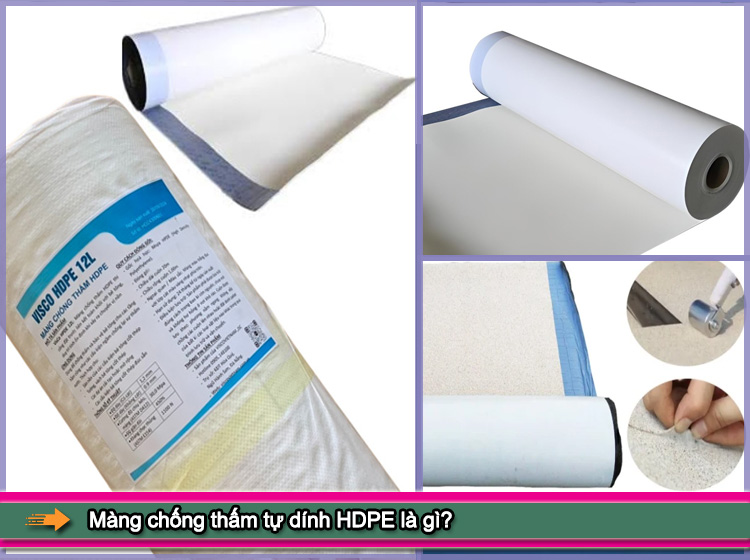
HDPE (High-Density Polyethylene) self-adhesive waterproofing membrane is a material made from Polymer, usually in the form of rolls or sheets. With the main component being virgin plastic accounting for 97.5%, HDPE membrane has high durability, meeting the strict requirements of many types of works. In addition, the HDPE membrane is also coated with silicon, helping the product to self-adhesive without the need for heat or complicated techniques.
Depending on the usage needs, self-adhesive HDPE waterproof membrane has a thickness of 0.3mm to 3mm. This is a type of membrane commonly used in civil and industrial construction works, thanks to its ability to effectively protect against the effects of water and the environment. The price of the product also ranges from 10,000 to 180,000 VND/m2, suitable for the budget of many projects.
Self-adhesive HDPE waterproof membrane stands out thanks to its outstanding advantages in terms of durability, applicability, and safety in construction. Here are the reasons why this product is the preferred choice of many contractors:
With the main ingredients of bitumen and HDPE coating, HDPE self-adhesive waterproofing membrane brings safety and convenience during construction. The product does not require hot air or the use of complex chemicals, helping to minimize risks and construction time. Construction becomes simpler when just need to stick the membrane directly onto the surface that needs waterproofing without heating.
One of the strengths of HDPE self-adhesive waterproofing membrane is its outstanding elasticity and adhesion. With high durability, the product can withstand harsh weather conditions without tearing or damage. This helps to prolong the life of the project, reduce maintenance and replacement costs.
HDPE waterproofing membrane can be applied in many different types of works such as diaphragm walls, concrete floors, swimming pools, bridges, and underground works. The product's outstanding waterproofing ability helps ensure the integrity and durability of the work over time.
Currently on the market, HDPE self-adhesive waterproofing membranes have many different brands and designs, meeting the specific requirements of each type of work. Customers can easily choose the product that suits their needs and economic conditions.
HDPE waterproofing membranes are used to help waterproof and moisture-proof effectively, and are easy to construct on many different types of construction surfaces, especially in areas requiring high waterproofing and protection. Below are some common applications of self-adhesive HDPE waterproofing membranes:
One of the most important applications of self-adhesive waterproofing membranes is to protect concrete structures from the effects of water and moisture. In the construction environment, ensuring that the foundation and main structures of the construction are waterproof is a vital factor. When used properly, self-adhesive waterproofing membranes will create a solid protective layer, helping to prevent water penetration, thereby limiting the risk of cracking, weakening the structure and prolonging the life of the construction.
The structure of a construction is often very complex with many different surfaces and angles. Self-adhesive waterproofing membranes have the outstanding advantage of being able to be applied to both vertical and horizontal surfaces, providing comprehensive protection for the construction. This is especially important for areas that are susceptible to water such as retaining walls, sloping roofs or vertical surfaces in basements and garages. This flexibility makes self-adhesive waterproofing membranes the optimal choice for contractors when dealing with areas that are difficult to access or have complex structures.
Areas that are susceptible to moisture such as roofs, partition walls, and low roofs are often weak points of the construction if not properly protected. Self-adhesive waterproofing membranes are designed to resist water penetration, preventing leakage and corrosion over time. Applying self-adhesive waterproofing membranes in these areas not only increases durability but also reduces maintenance costs throughout the life of the construction. In particular, with a simple construction process, this product still ensures outstanding waterproofing efficiency, bringing peace of mind to users.
Underground works such as basements, water tanks, and sewer systems are often subjected to very high groundwater pressure. Waterproofing these areas is very important to prevent water from entering and causing damage. HDPE self-adhesive waterproofing membranes are widely used in these works thanks to their absolute waterproofing ability, high adhesion and ability to withstand high water pressure. This ensures that underground areas are always dry and safe, prolonging the life of the work and reducing future repair costs.
Terraces and balconies are areas that are directly exposed to the weather, especially rain and wind. If not well waterproofed, water can seep through and damage the structures below, leading to cracking and peeling. Self-adhesive HDPE waterproofing membranes are effectively used in waterproofing terraces and balconies, helping to prevent leakage, ensuring the sustainability and safety of the entire project.
In addition to applications in construction, self-adhesive HDPE waterproofing membranes are also used in drainage systems and technical infrastructure. For example, this membrane can be used to protect water pipes, technical tunnels, and other infrastructure works from groundwater intrusion. This helps maintain the integrity and operational efficiency of important systems over a long period of time.
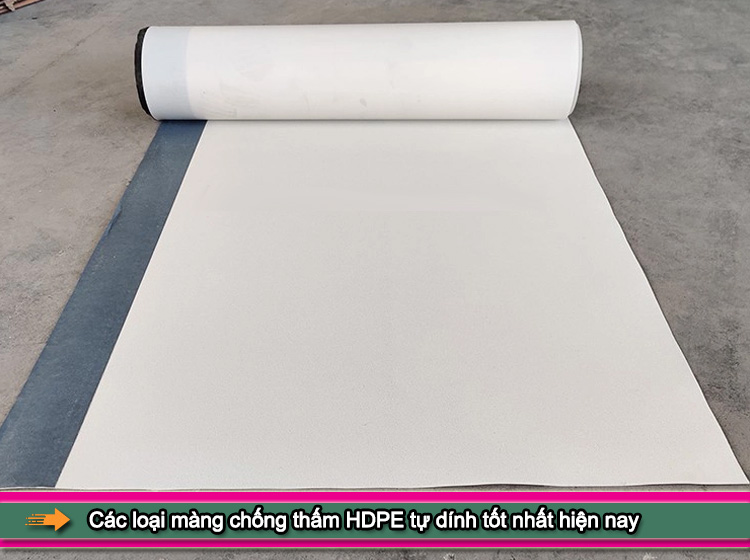
With the ability to waterproof and protect structures from water penetration and corrosive elements, self-adhesive waterproofing membranes are increasingly popular. However, choosing the most suitable and effective type of membrane is always a problem that many people are concerned about. Below are some of the most popular types of self-adhesive waterproofing membranes today:
a. Outstanding features:
Bitustick bitumen self-adhesive waterproofing membrane is made of polymerized bitumen, combined with a high-density polyethylene coating on the surface and silicon on the bottom. This is a prominent membrane thanks to its self-adhesive feature, easy to construct without the need for complicated heating methods. The current reference price is about 83,000 VND/m², however, the specific price may fluctuate depending on the supplier.
b. Advantages:
- High adhesion: Bitustick waterproofing membrane has excellent adhesion on both horizontal and vertical surfaces, especially on concrete.
- Heat and chemical resistance: The product is resistant to high temperatures, as well as chemical agents such as Chlorine, Sulfate, diluted alkali and acid.
- Outstanding durability: Bitustick waterproofing membrane has very good puncture and vehicle resistance, ensuring a long service life.
- Environmentally friendly: The material of the membrane is not harmful to the environment and can be used for a long time without losing quality.
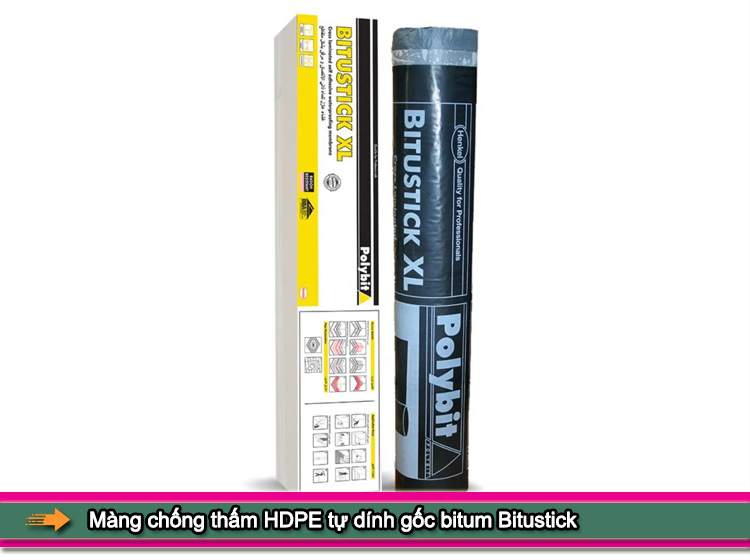
c. Application:
Bitustick waterproofing membrane is widely used in projects such as waterproofing water tanks, swimming pools, balconies, and areas requiring high humidity resistance. In particular, this product is very suitable for low-lying areas.
d. Construction instructions:
Construction of Bitustick waterproofing membrane must follow the following basic steps:
- Surface preparation: Ensure the construction surface is clean, remove dirt and create a flat surface.
- Cutting and spreading the membrane: Measure and cut the membrane to the required size, then spread it evenly on the surface.
- Sticking the membrane: Peel off the silicone layer and stick the Bitustick membrane on the surface, ensuring the distance between the joints is at least 50mm.
- Pressing the membrane: Use an iron roller to press the membrane, ensuring adhesion.
- Finishing: Cover with a layer of sand cement to protect the waterproofing membrane.
a. Outstanding features:
PVC waterproofing membrane is produced from Polyvinyl Chloride and special additives, helping to enhance anti-aging ability. With advanced production technology, PVC membrane is not only durable but also flexible during use.
b. Advantages:
- Good elasticity: PVC membrane has high elasticity, can withstand mechanical impacts without tearing or breaking.
- Temperature resistance: The product can work well in changing temperature conditions, from cold to hot.
- High durability: PVC membrane has long-lasting durability, is less prone to aging, and is especially suitable for outdoor projects.
- Easy construction: PVC membrane is connected by heat, creating strong and durable welds.
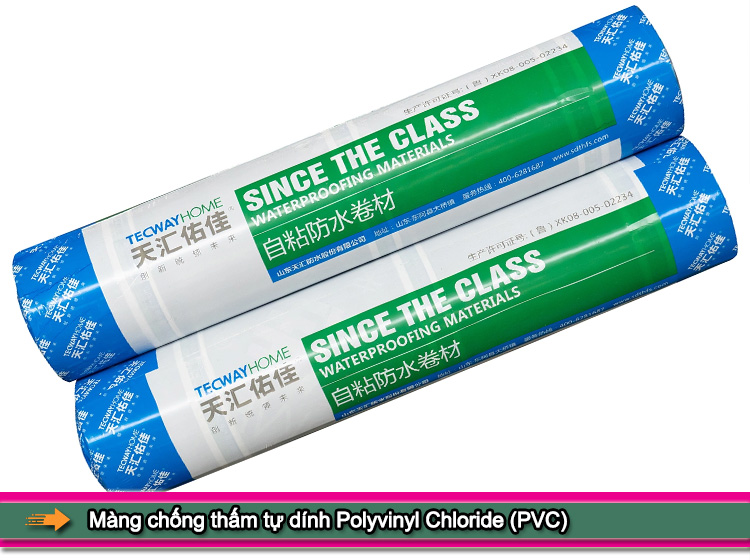
c. Application:
PVC waterproof membrane is suitable for a variety of projects, from waterproofing roofs, factories, underground water tanks to wastewater treatment at livestock farms. In addition, it is also used to line shrimp ponds, salt fields, and areas requiring high waterproofing such as basements or water tanks.
d. Construction instructions:
The PVC membrane construction process includes the following steps:
- Surface preparation: Spread the air barrier layer and bond the insulation layer.
- Edge joining: Joining the horizontal and vertical edges of the membrane.
- Membrane fixing: Firmly fix the membrane in the necessary positions and handle important points.
- Acceptance: Carefully check the construction quality before completion.
a. Outstanding features:
Autotak self-adhesive waterproofing membrane is made from bitumen combined with SBS (Styrene Butadiene Styrene), a high-strength thermoplastic rubber compound. The membrane structure includes a protective stone layer on the surface and a strong adhesive layer on the bottom, creating a product with effective adhesion without the need for heat during construction.
Currently, this product costs about 98,000 VND/m², a reasonable price for projects requiring superior waterproofing ability.
b. Advantages:
- Easy and safe construction: Unlike many other types of waterproofing membranes that require heat to create adhesion, Autotak can be attached directly to the cement surface without the need for heat. This minimizes the risk of labor safety during construction.
- Automatically seals small holes: The SBS coating helps the product automatically seal small holes, improving the ability to protect the construction from water and other harmful agents.
- Fast construction time: Autotak waterproofing membrane can be installed quickly, saving time and construction costs while still ensuring good adhesion to the concrete surface.
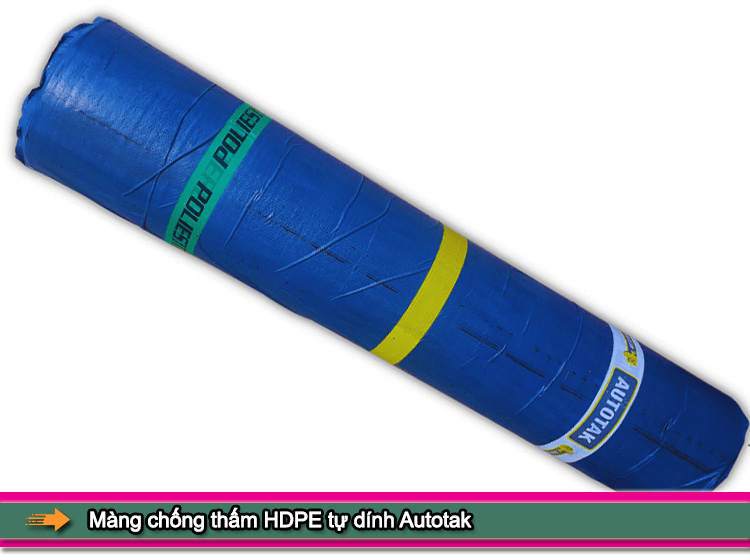
c. Application:
Autotak self-adhesive waterproofing membrane is widely used in constructions that require waterproofing such as:
- Flat roofs and low roofs: Autotak helps prevent water seepage from rain and humidity, protecting the structure of the construction.
- Foundation: The product ensures effective waterproofing for the foundation, preventing water seepage from underground.
- Public works: Especially suitable for areas such as swimming pools and tunnels, where high waterproofing ability is required.
d. Construction instructions:
To ensure optimal efficiency, the construction process of Autotak self-adhesive HDPE waterproofing membrane must follow these steps:
- Surface cleaning: Ensure the surface to be constructed is clean, free of dust, grease or impurities.
- Prepare the drain pipe mouth: Coat a layer of cement mortar at the mouth of the water pipe to create a smooth surface, convenient for construction.
- Bitumen primer: Roll a layer of bitumen primer onto the entire surface at a rate of 0.17-0.2 liters/m² to increase the adhesion of the self-adhesive membrane.
- Autotak membrane construction: After the glue layer dries, proceed to stick the waterproofing membrane, ensuring a minimum distance of 2cm between the membrane layers.
- Finishing and checking: Use a roller or step gently to ensure the membrane adheres firmly to the concrete floor surface.
a. Outstanding features:
Polyurethane self-adhesive waterproofing membrane is made from thermoplastic rubber compounds, providing superior waterproofing and high durability. The special feature of PU membrane is its immunity to both inorganic and organic substances, and is completely water-resistant.
With a starting price of 137,000 VND/kg, this is a worthy choice for those looking for an effective, safe and durable waterproofing solution.
b. Advantages:
- Easy to construct: PU membrane construction is very simple, can be rolled or sprayed directly onto the surface that needs waterproofing. This helps save time and effort during construction.
- UV and weathering resistance: The product has very good UV and weathering resistance, ensuring a long life for the project even in harsh weather conditions.
- Perfect insulation: Thanks to its ability to reflect sunlight, PU membrane provides effective insulation, reducing the temperature of areas directly exposed to sunlight.
- Stable mechanical properties: PU membrane maintains stable mechanical properties in a wide temperature range from -40°C to 90°C, allowing applications in many different environments.
- Chemical resistance: PU waterproof membrane is resistant to most chemical agents, including detergents, oils, and seawater, increasing the durability and protection efficiency of the project.
- Easy to restore: When damaged by impact, PU membrane can be easily restored without affecting the entire structure, helping to save repair costs.
c. Application:
Polyurethane self-adhesive waterproofing membranes are widely used in many different fields, including:
- Balconies, terraces and corridors: PU self-adhesive waterproofing membranes are effective in waterproofing areas that are exposed to a lot of rainwater, helping to protect the surface from water penetration.
- Wet areas: The product is very suitable for areas such as bathrooms and kitchens, where high humidity and effective waterproofing are required.
- Traffic and vehicles: PU self-adhesive waterproofing membranes are used in waterproofing traffic works, parking lots, and vehicles with high durability requirements.
- Rooftop gardens and landscapes: PU self-adhesive waterproofing membranes help protect rooftop planting areas and flower pots from water penetration, preventing soil degradation and building structure degradation.
- Protecting foam insulation panels: In insulation systems, PU self-adhesive waterproofing membranes are used as an effective protective layer for Polyurethane foam panels, preventing water penetration and environmental impacts.
d. Construction instructions:
Construction of Polyurethane (PU) waterproofing membranes requires careful preparation and proper implementation of the process to ensure optimal waterproofing efficiency. Below are the standard construction steps:
- Surface preparation: Ensure that the surface to be waterproofed is clean, free of grease, dirt or impurities. Cracks and holes on the surface must be filled with mortar or specialized glue. The surface humidity must be below 5%. If the surface is too wet, it must be treated or dried before applying the PU membrane.
- Primer: Use a primer suitable for the PU membrane to enhance adhesion. Usually a Polyurethane-based primer.
Apply a primer coat by roller or spray an even coat of primer onto the surface at a rate of about 0.2-0.3 liters/m². Wait for the primer to dry completely (usually 2-4 hours) before moving on to the next step.
- Applying Polyurethane (PU) waterproofing membrane:
» First coat: Use a brush, roller or specialized paint sprayer to apply the first PU waterproofing membrane layer. Ensure the coating is even and uninterrupted. The thickness of the PU waterproofing membrane should be from 1.0mm to 1.5mm, depending on the technical requirements and environmental conditions of the project. Wait for the first membrane to dry (about 6-8 hours, depending on weather conditions).
» Apply the second coat: Re-check the surface of the first membrane to ensure there are no defects. Apply the second PU membrane layer perpendicular to the first layer to ensure even coverage and avoid potential cracks. The total thickness after two layers should be about 2.0mm.
- Protection and maintenance:
» Protection: Avoid exposing the newly constructed PU membrane surface to water or strong impacts within 24-48 hours after construction.
» Maintenance: After 7 days, the PU membrane will reach maximum mechanical strength and be ready for use. If necessary, an additional UV protection layer or other finishing layer can be applied to extend its life.
* Notes during construction:
» Weather conditions: Avoid constructing PU membrane in extremely humid or rainy weather conditions, the appropriate temperature is from 5°C to 35°C.
» Labor safety: Ensure workers wear full protective gear, including gloves, goggles, and chemical masks during construction.
a. Outstanding features:
Self-adhesive HDPE waterproofing membrane is an outstanding product in the self-adhesive waterproofing membrane line, with the main membrane layer made from high-density polyethylene HDPE (High-Density Polyethylene). The elasticity and flexibility of this material not only makes construction easier but also ensures long-term waterproofing, especially durable.
Currently, HDPE self-adhesive waterproofing membrane has a starting price of 31,800 VND/m2, lower than many other similar products on the market, but still provides optimal protection for the project.
b. Advantages:
Self-adhesive HDPE waterproofing membrane is highly appreciated for its many outstanding advantages:
- Good durability and load-bearing capacity: With a high-density polyethylene structure, this product has good resistance to physical impacts and harsh environmental conditions. It is not easily torn or damaged when exposed to external pressure.
- Elasticity and flexibility: HDPE has an elasticity of up to 700%, helping the product easily adapt to changes in size and shape of the construction surface. This means that the construction and transportation of waterproofing membranes become simpler and more flexible.
- Resistance to extreme temperatures and UV resistance: The product can withstand temperatures as low as -25 degrees Celsius without becoming brittle or cracked. In addition, UV resistance helps HDPE waterproofing membranes maintain their properties for a long time, even when exposed to direct sunlight.
- Long life: One of the factors that makes HDPE waterproofing membrane attractive is its lifespan of up to 50 years. This helps save maintenance and replacement costs throughout the life of the project.
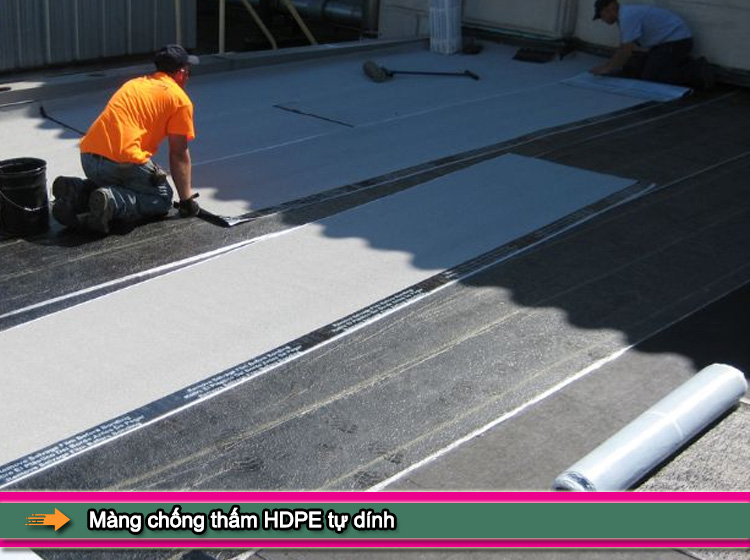
c. Applications:
Thanks to its superior features, self-adhesive HDPE waterproofing membranes are widely used in many fields, including:
- Base lining for construction works: Self-adhesive HDPE membranes are often used as a base lining to prevent water seepage from the ground to the construction. This is especially important for works such as basements, roofs and areas in direct contact with the ground.
- Waste and odor treatment: This product is also used in Biogas projects, where high waterproofing ability is required to prevent odors from landfills. This is an effective solution in controlling the environment around waste treatment areas.
- Application in aquaculture: In the aquaculture industry, HDPE waterproofing membranes are often used as linings for fish ponds, helping to prevent water infiltration and minimize the penetration of pollutants.
d. Construction instructions:
The construction process of self-adhesive HDPE waterproofing membranes requires technique and meticulousness to ensure maximum waterproofing efficiency. The steps include:
- Surface preparation: The construction surface needs to be thoroughly cleaned, removing dirt, rocks and grease. This helps the membrane adhere firmly to the surface, avoiding peeling or open edges.
- Primer coating: The primer is painted at a rate of 4m2 - 6m2/liter to help create better adhesion between the waterproofing membrane and the construction surface.
- Spreading and fixing the membrane: After the primer has dried, the HDPE waterproofing membrane is spread from the lowest position and overlapped properly. This helps ensure a solid bond between the membrane layers.
- Gluing and finishing: The silicone membrane is peeled off to reveal the self-adhesive layer, then the HDPE membrane is glued to the surface. Use an iron roller to compress the membrane, ensuring that there is no trapped air and the membrane adheres firmly to the surface.
»» In summary: Self-adhesive HDPE waterproof membrane is an effective solution for construction projects, especially in harsh environmental conditions. With the advantages of durability, optimal waterproofing, and long life, this product deserves to be the top choice for waterproofing projects that require long-term and sustainable protection.